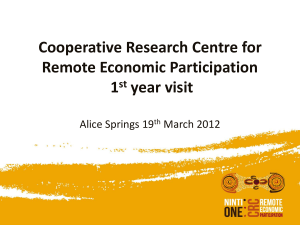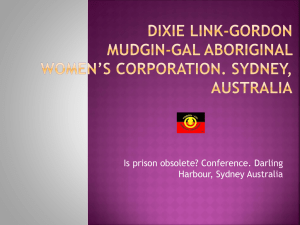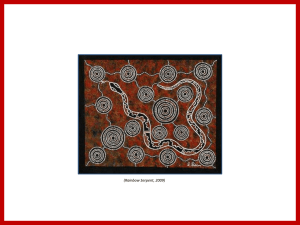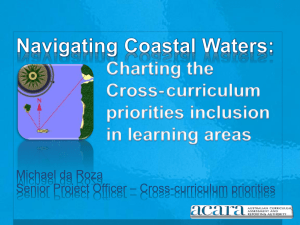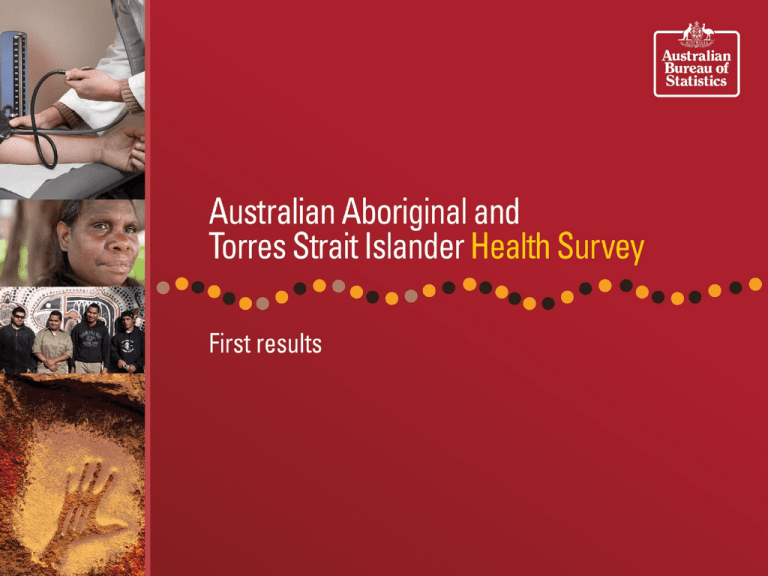
Structure of the Australian Aboriginal and Torres Strait Islander Health Survey
Sample Size = 7,700 Households, 12,300 people
2 Adults + 2 children (non-remote) - 5900 persons
1 Adult + 1 child (remote) - 3400 persons
NATIONAL ABORIGINAL AND TORRES STRAIT
ISLANDER HEALTH SURVEY (NATSIHS)
Long-term health conditions
Health-related actions
Disability and recent injuries
Breastfeeding (0-3)
Days of reduced activity (5+)
Physical activity (5+)
Personal income (15+)
Family stressors (15+)
Immunisation (15+)
Alcohol & substance use (15+)
Private health insurance* (15+)
Female contraception (18-49)
Social & emotional wellbeing (18+)
Cultural identification (18+)
Discrimination (18+)
Male contraception (18+)
Women’s health (e.g. pap smears) (18+)
*Excludes remote
communities.
Population is all persons
unless otherwise
indicated.
1 Adult + 1 child (2+)
Non-remote - 1250 persons
Remote - 1750 persons
CORE CONTENT
1 Adult + 1 child (2 yrs +)
NATIONAL ABORIGINAL AND TORRES STRAIT
ISLANDER NUTRITION AND PHYSICAL
ACTIVITY SURVEY (NATSINPAS)
Household information
Demographics
Fruit & vegetable intake (2+)
Salt use (2+)
Physical measurements (2+)
Blood pressure (5+)
Self-assessed body mass (15+)
Smoking (15+)
Self-assessed health (15+)
NATIONAL ABORIGINAL AND TORRES STRAIT
ISLANDER HEALTH MEASURES SURVEY
(NATSIHMS)
All adult survey participants invited to
VOLUNTEER
Key blood and urine tests of nutritional status
and chronic disease markers (18+)
Dietary recall
Physical activity
Selected conditions
NATSINPAS
Telephone follow-up*
(Non-Remote)
2nd dietary recall
8-day pedometer (5+)
Some key questions
For Aboriginal and Torres Strait Islander people:
How do they perceive their health?
What kind of health conditions are most prevalent?
Are people using health services more?
Some key questions
Have smoking rates declined?
What are the patterns of alcohol consumption?
Are overweight/obesity rates different for males
and females?
Headline results
Since 2002, the proportion of Aboriginal and
Torres Strait Islander people who, in 2012-13:
smoke on a daily basis…has fallen
have never smoked …has increased
Fewer smokers
Aboriginal and Torres Strait Islander people 15 years and
over, smoker status, 2002, 2008 & 2012-13
60
50
%
40
49
Current daily
smokers
45
41
34
33
Never
smoked
37
30
20
20
15
21
10
0
2002
2008
2012-13
Ex-smokers
Smoking by remoteness
Aboriginal and Torres Strait Islander people 15 years and over,
current daily smokers, by remoteness, 2002, 2008 & 2012-13
60
50
48
50
43
40
%
50
49
38
30
20
10
0
2002
2008
2012-13
Non-remote
Remote
Fewer young smokers
Aboriginal and Torres Strait Islander people 15-24 years,
smoker status, 2002 and 2012-13
60
50
54
44
Current daily
smokers
44
40
34
Never
smoked
% 30
20
Ex-smokers
10
7
10
0
2002
2012-13
Consuming alcohol
Proportion of Aboriginal and Torres Strait Islander people
15 years and over, who had consumed alcohol in the past
year, 2012-13
100
77
80
68
Males
%
60
40
20
0
Females
Risky levels of alcohol consumption
Single occasion risk – ‘no more than 4 standard
drinks on a single occasion reduces the risk of
alcohol-related injury arising from that occasion’.
Lifetime risk – ‘no more than 2 standard drinks on
any day reduces the lifetime risk of harm from
alcohol-related disease or injury’.
*NHMRC guidelines 2009
Alcohol - single occasion risk
Aboriginal and Torres Strait Islander people 15 years and
over, exceeded guidelines for single occasion risk, 2012-13
70
60
50
% 40
30
20
10
0
64
55
44
48
Male
Female
Non-remote
Remote
Alcohol - lifetime risk
Aboriginal and Torres Strait Islander people 15 years and over,
exceeded guidelines for lifetime risk, remoteness and sex 2012-13
30
26
25
18
20
% 15
10
5
0
10
17
Males
Females
Non-remote
Remote
Perceptions of Health
Aboriginal and Torres Strait Islander people 15 years and over,
self-reported health status, 2012-13
40
35
30
25
%
20
15
10
5
0
36
26
18
13
7
Excellent Very good
Good
Fair
Poor
Long-term health conditions
In 2012-13, 45% of Aboriginal and Torres Strait
Islander people were living with 3 or more longterm health conditions.
-The comparable non-Indigenous rate was 39%.
*Age standardised
Long-term health conditions
Aboriginal and Torres Strait Islander people living with long
term health conditions, 2012-13
40
35.3
35
30
25
%
20
23.2
21.2 20.3
Non-remote
14.1
15
Remote
11.6
10
5
0
One health condition
Two or more health
conditions
Three or more health
conditions
Overweight and obesity
Aboriginal and Torres Strait Islander people 15 years and over,
Obesity and overweight rates by sex, 2012-13
%
45
40
35
30
25
20
15
10
5
0
40
34
30
36
33
27
Male
Female
Overweight
Obese
Neither overweight nor
obese
Health-related actions
Proportion of Aboriginal and Torres Strait Islander people who had consulted with
health professionals in the previous 2 weeks, 2012-13
38
40
35
30
30
%
23
25
20
15
10
5
20
17
16
12
5
5
25 26
With
GP/specialist
28
24
4
5
5
With other
health
professional
22
19
21
6
5
0
0–14
15–24
25–34
35–44
45–54
Age group (years)
55 and over
Total
With dental
professional
Prevalence of health conditions and health risks
Compared with non-Indigenous Australians in 2012-13,
Aboriginal and Torres Strait Islander people:
all ages - 3.3 times more likely to be living with
diabetes
15 years & over - 2.6 times more likely to be a daily
smoker
15 years & over - 1.5 times more likely to be obese
More information
Release schedule:
Updated results (June 2014)
ABS National Information
Referral Service:
1300 135 070
Biomedical Results
(September 2014)
www.abs.gov.au
First Results – Nov 2013
(cat. no. 4727.0.55.001)
Physical Activity (September
2014)
Nutrition — Foods, Nutrients
and Supplements
(September 2014)
www.facebook.com/absstats
Questions…???




